Service hotline
+86 0755-83044319
release time:2023-10-17Author source:SlkorBrowse:18488
About Slkor:
Slkor is headquartered in Shenzhen, Guangdong Province, China. The company's development is driven by new materials, new processes, and new products. The Slkor technical team is mainly composed of experts from Yonsei University in South Korea and Tsinghua University in China. They have mastered the internationally leading production process of silicon carbide MOSFETs and fifth-generation ultra-fast recovery power diode technology. From its initial status as a fabless design company, Slkor has evolved into an integrated company that combines design research and development, manufacturing, sales, and technical services. Slkor is a national high-tech enterprise and has obtained ISO9001 quality management system certification as well as EU certifications such as ROHS and REACH.
Slkor has research and development institutions in Busan, South Korea, Beijing, and Suzhou, China. Most of the wafer manufacturing and chip packaging and testing are done within China. The headquarters in Shenzhen has laboratories and a central warehouse. The company's international cooperation network extends across the globe, serving over ten thousand customers worldwide. Slkor has applied for one hundred conditionally patented inventions and offers over 2000 product models. They have established comprehensive management systems and streamlined workflows. With excellent quality and standardized services, the "SLKOR" brand has rapidly gained recognition, reputation, and market share. Slkor's products include diodes, transistors,discrete power devices, and power management chips, categorized into three major series. They have also introduced new products such as Hall sensors, ADCs, and BMS. The company has accumulated years of technical expertise in specialized MCUs and interface chips.
1. Application Guide
Small relays are commonly used in electronic systems to control circuit switching, and they have widespread applications in industrial equipment, instruments, and household appliances. The heart of modern control circuits is usually computer chips such as MCUs, DSPs, and FPGAs. These core chips do not have enough output power to directly control small relays and can be driven by SLKOR's small transistors BC817-25, BC848B, BC847B, and small MOSFETs 2N7002E, SL2302S, SL2300, SL3400, SL3402, and Darlington arrays ULN2001D, ULN2003AU, ULN2803AS, etc.
In the following example, we will use the driving of a small high-power relay JQC-3FF/12VDC-1ZS (551) from HF as an example. The coil of the relay has a rated voltage of 12V, an action voltage of 9V, a maximum voltage of 15.6V, and a coil resistance of 400Ω. When powered by 12V, the coil current is 30mA. Here we will introduce the design of driving the small relay using BC848B, SL2302, and ULN2803AS, respectively. Taking the STM32F030C8T6 MCU as an example, any IO pin can provide a maximum limit of 25mA of pull-up or pull-down current, and the total limit of pull-up or pull-down current for all IO pins is 80mA. Therefore, when applying the IO pins, there should be enough margin. The typical value of the weak pull-down resistor for the IO pin is 40KΩ. When powered by 3.3V, if the IO pin outputs 8mA of current, the minimum output high level is 2.9V, and if the IO pin pulls 8mA of current, the maximum output low level is 0.4V.
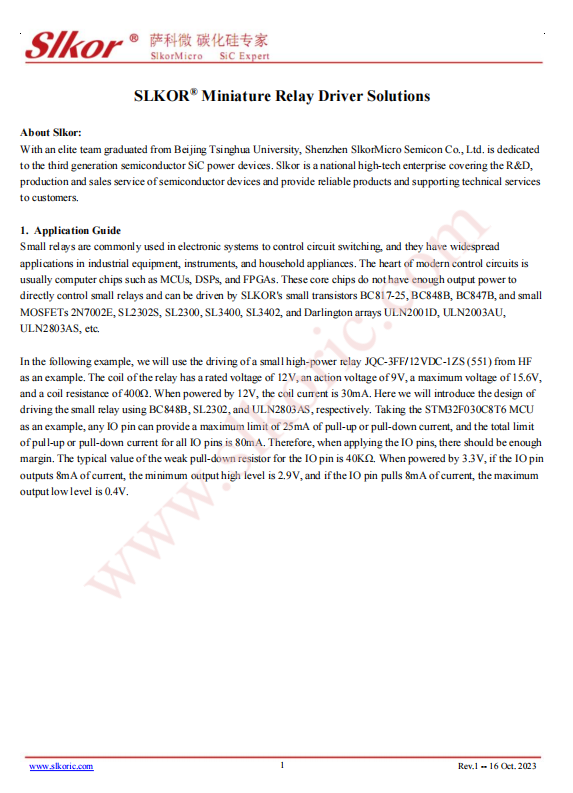
2. Using SLKOR® BC847B to Drive
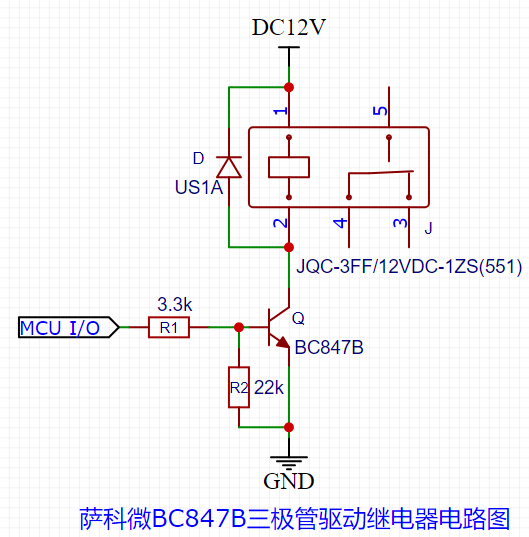
The collector-emitter voltage (VCEO) of the BC847B transistor is 45V, and the collector current (IC) is 100mA. The DC current gain (HFE) ranges from 200 to 450, and the maximum collector-emitter saturation voltage is 600mV. The typical input capacitance (CIB) is 9pF.
When driving a relay coil, the transistor operates in either cutoff (relay release) or saturated conduction (relay actuation) state.
During the transition from relay actuation to release, the relay coil generates a back electromotive force (EMF). The energy stored in the coil is discharged through the freewheeling diode (D) and the coil's resistance. The back EMF is clamped to a forward voltage drop of 0.7V across the diode, which is much lower than the breakdown voltage of the transistor, thus protecting the transistor.
The values of resistors R1 and R2 in the circuit must ensure that the transistor reliably enters deep saturation when the input voltage is 2.9V. Assuming an HFE of 200 for the BC847B transistor and a relay drive current of 30mA, the base current (IB) is calculated as 0.15mA (30mA/200). To ensure deep saturation, the base current is increased to 0.3mA. Assuming the base-emitter voltage (VBE) is 0.7V when the BC847B transistor is saturated and the high-level output voltage of the STM32F030C8T6 microcontroller (MCU) is at least 2.9V, the voltage across resistor R1 should be 2.2V.
Resistor R2 is added to reliably cutoff the BC847B transistor under adverse conditions. When VBE is 0.7V, the current through R2 is IR2=0.7/22=0.032mA. To ensure deep saturation, the total current through resistor R1 should be IR1=0.3+0.032=0.332mA. Therefore, the maximum resistance value for R1 is R1=2.2/0.332=6.63KΩ. Choosing R1 as 3.3KΩ ensures that the BC847B transistor can enter deep saturation even with component parameter variations. In deep saturation, when the power supply is 12V, the minimum relay drive voltage is 11.4V, which is sufficient to ensure reliable relay actuation.
The time constant for conduction can be roughly estimated as R=R1|R2=2.9KΩ, and RC=2.9KΩ*9pF=26.1pS. The transition process time is extremely short!
When the STM32F030C8T6 MCU outputs a low-level voltage, which is at most 0.4V, the base-emitter voltage of the BC847B transistor is less than 0.4V, ensuring reliable cutoff for relay release.
To ensure maximum reliability, it is recommended to enable the weak pull-down resistors (typical value of 40KΩ) for the I/O port configured in the software for the STM32F030C8T6 MCU.
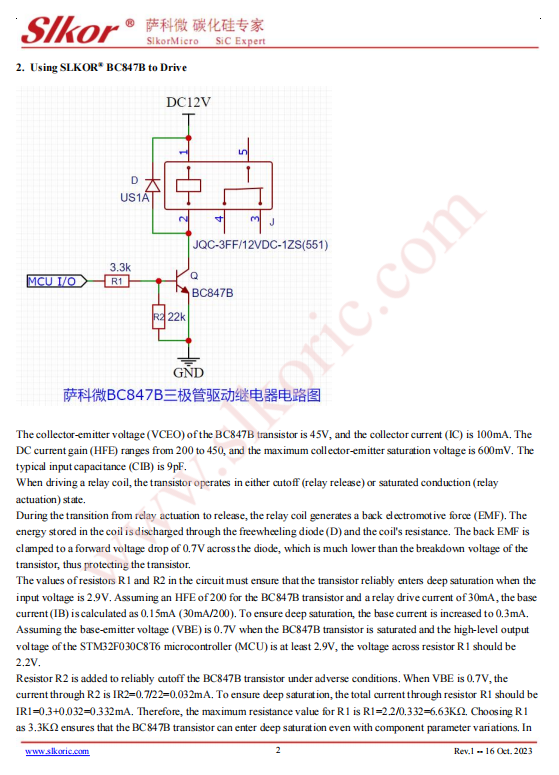
3. Using SLKOR® SL2302 to Drive
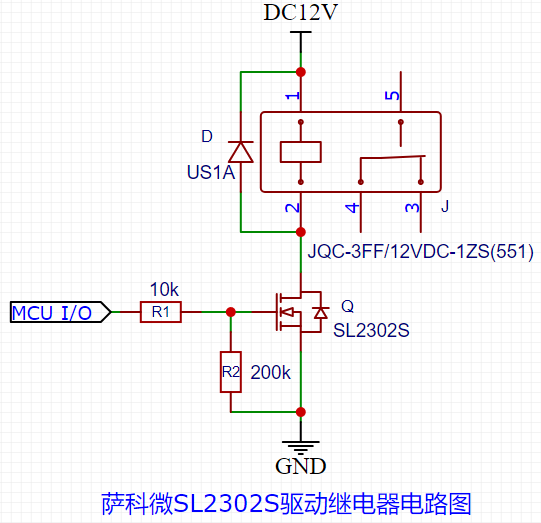
The SLKOR SL2302 is an N-channel small signal MOSFET. Its maximum drain-source voltage (VDS) is 20V, maximum gate-source voltage (VGS) is 12V, and maximum on-resistance (RDS(on)) is 85mΩ at VGS = 2.5V and ID = 3.1A. The maximum threshold voltage (VGS(th)) for gate conduction is 1.2V, while the minimum is 0.65V. The typical input capacitance (CISS) is 300pF.
When the STM32F030C8T6 outputs a high-level voltage of at least 2.9V, assuming R1 = 10KΩ and R2 = 100KΩ, the steady-state voltage on the SL2302 gate (VGS D) is calculated as (100/(100+10))*2.9 = 2.64V. This ensures that the SL2302 remains in a reliable state of super saturation conduction. When in super saturation, the conduction resistance of the SL2302 is no higher than 85mΩ. Assuming a 12V power supply, the relay drive voltage is very close to 12V, which is sufficient for reliable relay actuation.
When the STM32F030C8T6 outputs a low-level voltage, with a maximum voltage of 0.4V, the SL2302 gate voltage is lower than 0.4V, ensuring reliable cutoff and allowing for the reliable release of the relay.
The time constant for conduction can be roughly estimated as R = R1|R2 = 9.1KΩ, and RC = 9.1KΩ * 300pF = 2.73ns. The transition process time is very short! When the relay transitions from actuation to release, the coil generates a back electromotive force (EMF). The energy stored in the coil is discharged through the freewheeling diode (D) and the coil's resistance. The back EMF is clamped to a forward voltage drop of 0.7V across the diode, which is much lower than the breakdown voltage of the MOSFET, thus protecting it. To ensure maximum reliability, it is recommended to enable the weak pull-down resistor (typical value of 40KΩ) for the I/O port configured in the software for the STM32F030C8T6.
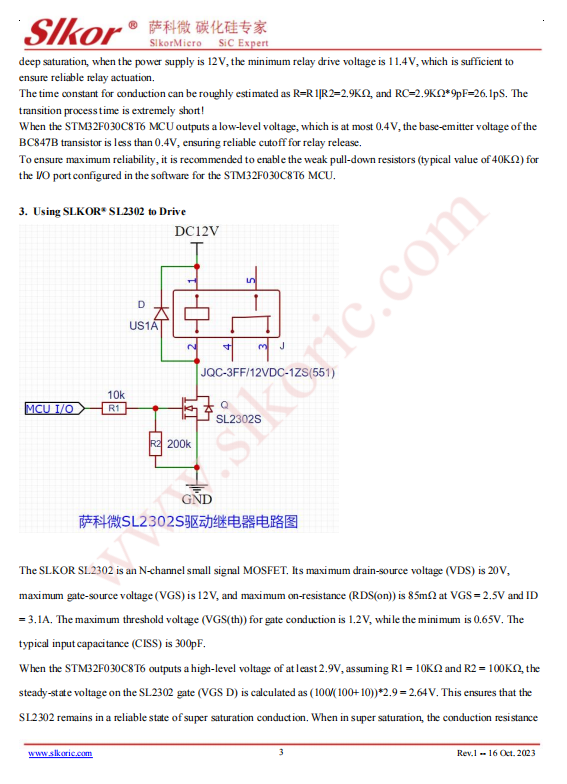
4. Using SLKOR® ULN2803AS to Drive
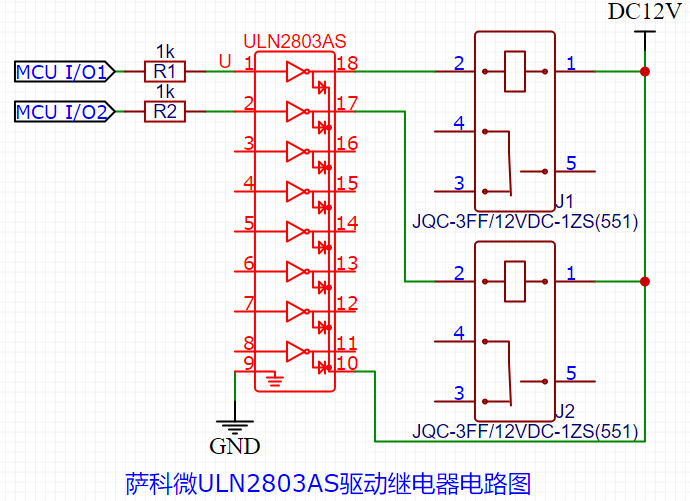
The STM32F030C8T6 is used as the main controller, and most of its I/O ports can directly drive the inputs of the ULN2803AS. The minimum high-level output voltage is 2.9V, and the maximum low-level output voltage is 0.4V, which fully meets the requirements for driving the ULN2803AS. To improve the interference immunity of the STM32F030C8T6, a 560Ω resistor can be connected in series between its I/O port and the input of the ULN2803AS. For driving small relays, the internal freewheeling diodes of the ULN2803AS provide sufficient freewheeling capability, so there is generally no need to add additional freewheeling diodes. If extremely high reliability is required, adding separate freewheeling diodes can be considered. The typical switching time of the ULN2803AS is around 1μs, and for driving small relays, no further calculation is needed.
Assuming a 12V power supply, the minimum relay drive voltage is 10.9V, which is sufficient for reliable relay activation. When the STM32F030C8T6 outputs a low-level voltage, with a maximum voltage of 0.4V, the ULN2803AS can reliably cut off and release the relay.
To ensure maximum reliability, it is recommended to enable the weak pull-down resistor (typical value of 40KΩ) for the I/O port configured in the software for the STM32F030C8T6.
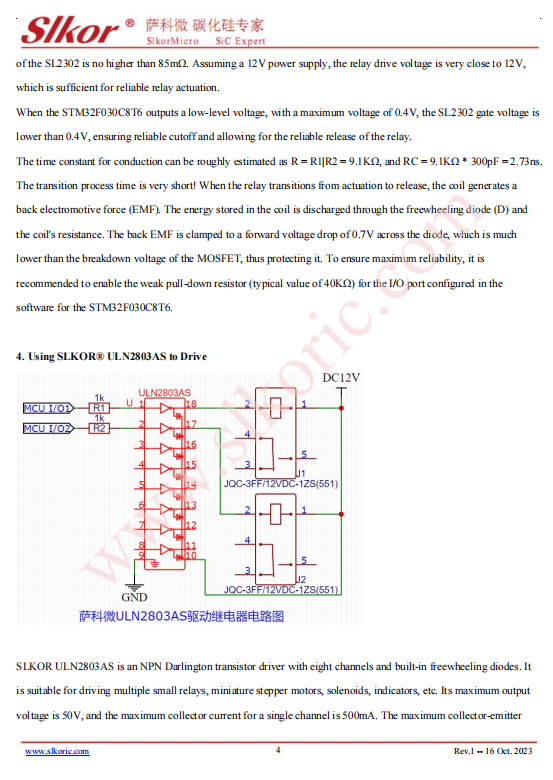
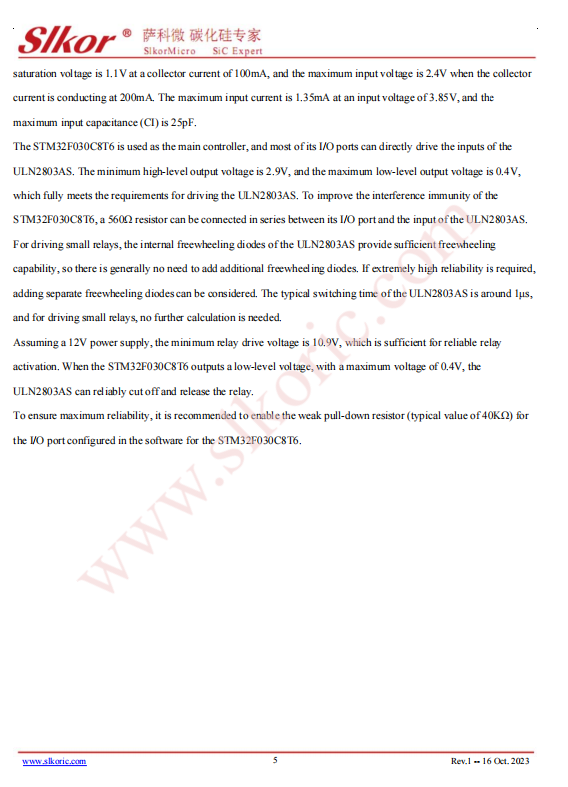
SLKOR offers high-end products such as silicon carbide (SiC) diodes and SiC MOSFETs, IGBTs, and fifth-generation ultra-fast recovery power diodes, which can meet the needs of industries such as new energy vehicles, high-end equipment, communication and power, photovoltaic solar energy, medical equipment, and industrial internet. SLKOR also provides general-purpose products such as Schottky diodes, ESD protection diodes, and TVS transient suppression diodes, as well as power devices such as high-voltage MOSFETs, medium-voltage MOSFETs, and low-voltage MOSFETs, thyristors, and Silicon control rectifier SCR, and power management chips such as LDOs, AC-DC, and DC-DC chips. Additionally, SLKOR offers complementary services such as sensors, high-speed optocouplers, and crystal oscillators for various applications in products such as smartphones, laptops, robots, smart homes, IoT, LED lighting, 3C digital products, smart wearables, and IoT.
SLKOR is dedicated to building a platform that is ecological, composite, and inclusive. The company's official website has columns for technical blogs, expert column, solutions, electronic blogs, and industry dynamics. The "SLKOR Technology Lecture Hall" is being planned, with plans to invite international scholars and experts to give public lectures. There will be collisions of ideas, academic exchanges, and a feast of thoughts, providing a learning and communication platform for electronic information colleagues. SLKOR also integrates the spirit of unity, striving, and breakthroughs from sports into its work culture, advocating for happy work and a happy life. The company has formed the "SLKOR Warriors Basketball Team" and regularly holds various cultural and entertainment activities. SLKOR upholds the corporate culture of "Integrity, Progress, Tenacity, Detail," and an ethical value of fairness, openness, and cooperation, "Do not do unto others what you do not want done to yourself" working with suppliers, channel partners, customers, and cooperative partners to promote world development with technology and products, and achieve the company's vision of becoming a leader in the semiconductor industry.









Site Map | 萨科微 | 金航标 | Slkor | Kinghelm
RU | FR | DE | IT | ES | PT | JA | KO | AR | TR | TH | MS | VI | MG | FA | ZH-TW | HR | BG | SD| GD | SN | SM | PS | LB | KY | KU | HAW | CO | AM | UZ | TG | SU | ST | ML | KK | NY | ZU | YO | TE | TA | SO| PA| NE | MN | MI | LA | LO | KM | KN
| JW | IG | HMN | HA | EO | CEB | BS | BN | UR | HT | KA | EU | AZ | HY | YI |MK | IS | BE | CY | GA | SW | SV | AF | FA | TR | TH | MT | HU | GL | ET | NL | DA | CS | FI | EL | HI | NO | PL | RO | CA | TL | IW | LV | ID | LT | SR | SQ | SL | UK
Copyright ©2015-2025 Shenzhen Slkor Micro Semicon Co., Ltd